COMMONLY PERFORMED CLINIC ENT PROCEDURES
1. Radiofrequency Turbinate Reduction (RTR)
Indication– Nasal Obstruction due to Swollen Turbinates
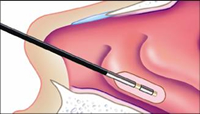
About the Procedure– A very common cause of nasal obstruction is hypertrophic (enlarged) turbinates. This can result from nasal allergy or infection. The turbinate is filled with spongy tissue rich in blood vessels that dilate in response to inflammation. Radiofrequency treatment is based on the application of thermal energy to the swollen tissue resulting in scarring of the spongy tissue. This scar tissue cannot expand and the turbinate remains shrunken for many years. Many studies have shown the significant change in the shape and size of the turbinate (see figure).
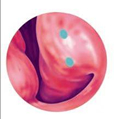
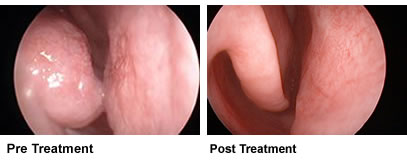
What to expect – RTR is performed in the clinic under local anaesthesia. It takes about 10 minutes to perform and is sometimes associated with very mild discomfort. The youngest patients Dr Chee has performed this procedure on in clinic are three 7-year olds. There may be some blood-staining from the nose the first day but this settles quickly. As the spongy tissue is replaced by scar tissue, crusts or slough forms and can be removed a few days after the procedure is done.
2. Coblation Assisted Uvulopalatoplasty (CAUP)
Indication – Snoring and Mild Obstructive Sleep Apnea (OSA)
About the Procedure – This procedure is performed in clinic under local anaesthesia and takes about 15 minutes to complete. Patients are given xylocaine gel which they hold in their mouth for about 10 minutes. This numbs the oral cavity so that an injection can be given to the soft palate to numb the area even more. Once that is done, the patient is seated upright and given a spatula to depress his own tongue. The surgeon will use coblation to make trenches in the soft palate so as to widen the throat opening. The uvula (long dangling thing in the mouth) is cut off. Coblation is also used to stiffen the palate.
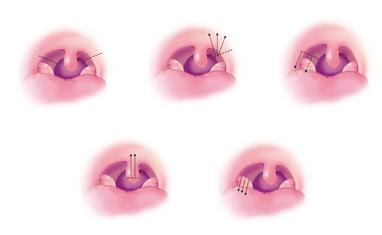
What to expect – There will some pain for about one week to 10 days and pain relief medication is given. There is a 2 to 3% risk of bleeding from the wound site as a result of infection. This is easily arrested if it occurs. Patients will generally notice improvement in their sleep quality and snoring about 2 weeks after the procedure is done.
3. Grommet Tube Insertion
Indication – Aspiration of middle ear fluid (Otitis Media), instillation of medications for Meniere’s disease and sudden onset sensorineural hearing loss (SSNHL).
About the Procedure – patients lie on a couch and local anaesthesia is injected into the external ear canal. This causes minimal but definite discomfort. A small incision is made in the lower, anterior (front) quadrant of the eardrum. Fluid is aspirated if present and a small Teflon tube is inserted into the hole made so that half sits in the middle ear and the other half sits in the external ear (see figure below).
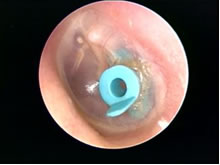
Grommet Tube
What to expect – There is no pain or discomfort after the procedure is done. Hearing is immediately restored if middle ear fluid was present. The ear should be kept dry and away from water. No swimming for at least two weeks. It takes about 6 to 9 months for the tubes to extrude whence it can be removed from the external ear canal with a fine forceps.
4. Silver
Nitrate Cautery
Indication – Little’s area epistaxis (bleeding from nose).
About the Procedure – the area is anesthetized with a cotton wool soaked with co-phenylcaine placed over the blood vessel. Silver nitrate comes at the tip of a stick and is applied directly to the blood vessel. The application itself takes 3 to 5 seconds. This procedure is suitable for children.
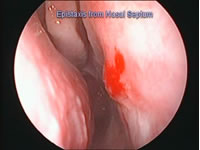
Septal Bleeder
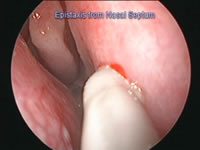
Application of Silver Nitrate
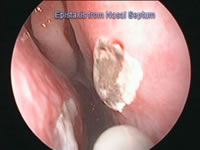
Grommet Tube
What to expect – The procedure is usually painless. Over the next few days, a scab will form and may peel off the septal mucosa.
Minor bleeding may occur when that happens but will resolve once the mucosa heals over. Nasal moisturization with seawater spray (eg Sterimar) may help premature scabbing.
5. Excision of Neck Lumps
Indication – to determine the nature and remove persistent neck lumps.
About the Procedure – this is performed under local anaesthesia for superficial neck lumps such as sebaceous cysts and lymph nodes. If the neck lump is large and deep, it may be wiser to have the procedure in a day surgery center under general anaesthesia. The neck is prepared in a sterile fashion and local anaesthesia is injected. An incision is made with a scalpel and the lump is isolated with forceps and scissors. Bleeding is controlled using electrocautery and the incision is closed with fine sutures.
What to expect – there may be mild discomfort after the procedure but generally no pain relief is required. The sutures need to be removed 5 to 7 days later. Histology results are ready after 2 to 3 days.
6. Antral (Sinus) Washout
Indication – to flush pus from maxillary sinus in sinusitis not responding to antibiotic therapy
About the Procedure – this procedure involves creating a small puncture in the bone that separates the nasal cavity and the maxillary sinus. The area is anaesthetized using cocaine-soaked patties placed under the inferior turbinates in the nose for 15 minutes. Through the nose and using minimal finger pressure, a trocar and cannula is used to puncture the maxillary sinus. Normal saline in a syringe is then used to irrigate the maxillary sinus.
What to expect – the procedure is usually painless. There may be some blood-stain discharge after the procedure that is self-limiting.
